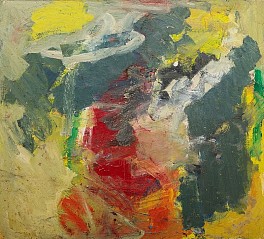BIOGRAPHY

American, 1918-2010
Pace (1918-2010) was a noted significant second-generation Abstract Expressionist painter. After 1962, he began to paint in a representational, minimalist mode using broad brush strokes and negative spaces to create lively Post-Impressionist inspired scenes of everyday life. In 1961, the noted critic Thomas Hess recognized Stephen Pace's place as an Abstract Expressionist, writing in the introduction to a show of his work: "Pace is a brilliant member of the second generation of New York School painters [who] burst on the scene in the early 1950s, fully made, as if from the forehead of the Statue of Liberty."
Stephen Pace studied with Hans Hofmann in Provincetown. There he garnered much praise from his mentor. From 1953 to 1961, Pace was often included in annuals at the Whitney Museum of American Art, exhibiting alongside Kline and Hofmann. In 1954, he was represented in the third annual exhibition at the historically important Stable Gallery. Art critic Dore Ashton wrote in 1960 that in Pace's abstractions, on view at Howard Wise Gallery, "energetic elements battle their way to equilibrium. No matter how baroque Mr. Pace's compositions are-and they are nearly all fretted with tilting and bucking forms-they do, ultimately come to rest." Note that this painting was exhibited at Howard Wise Gallery.
Another critic had this to say: "Lavish with both paint and energy, Stephen Pace employs jumbled layers of color, scumbled, splattered and overrun by lines and dribbles in a burst of disorder and chaos. The shapes which dimly emerge amid the tumultuous jostling are of a biomorphic character reminiscent of Gorky, but painted with a freedom and abandon which has a dizzying effect."
Pace's work is included the collections of the Hirshhorn Museum and Sculpture Garden, Washington, D.C.; the Metropolitan Museum of Art, New York; the Museum of Fine Arts, Boston; the National Academy of Design, New York; the Phillips Collection, Washington, D.C.; the Smithsonian American Art Museum, Washington, D.C.; and the Whitney Museum of American Art, New York.
Stephen Pace studied with Hans Hofmann in Provincetown. There he garnered much praise from his mentor. From 1953 to 1961, Pace was often included in annuals at the Whitney Museum of American Art, exhibiting alongside Kline and Hofmann. In 1954, he was represented in the third annual exhibition at the historically important Stable Gallery. Art critic Dore Ashton wrote in 1960 that in Pace's abstractions, on view at Howard Wise Gallery, "energetic elements battle their way to equilibrium. No matter how baroque Mr. Pace's compositions are-and they are nearly all fretted with tilting and bucking forms-they do, ultimately come to rest." Note that this painting was exhibited at Howard Wise Gallery.
Another critic had this to say: "Lavish with both paint and energy, Stephen Pace employs jumbled layers of color, scumbled, splattered and overrun by lines and dribbles in a burst of disorder and chaos. The shapes which dimly emerge amid the tumultuous jostling are of a biomorphic character reminiscent of Gorky, but painted with a freedom and abandon which has a dizzying effect."
Pace's work is included the collections of the Hirshhorn Museum and Sculpture Garden, Washington, D.C.; the Metropolitan Museum of Art, New York; the Museum of Fine Arts, Boston; the National Academy of Design, New York; the Phillips Collection, Washington, D.C.; the Smithsonian American Art Museum, Washington, D.C.; and the Whitney Museum of American Art, New York.
